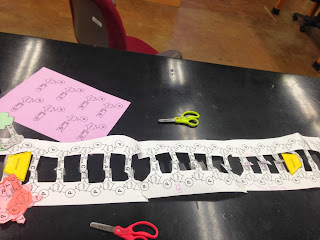I am really behind on my blog... Guess I'll just cramp a bunch of stuff into this ONE...
General Genetic Problems:
There are two ways. First is the Quick way:
Basically write out the possible combinations of the two traits and list the possibilities out in a huge square.
And then there's the Fitz's way:
Wowwww so much math!!! But I'm Asian so it's no big deal. Put the alleles that are in charge of the same traits in the same square and list all the possibilities out. And then calculate the ratios. Voila.
Genotype: The allele expression.
Phenotype: What the trait looks like.
Special Genetics:
Epistasis:
The different combinations of alleles creates different phenotypes. For example:
Incomplete Dominance:
Both alleles in heterozygous organism may be expressed in the phenotype. For example: Red rose x White rose = Pink rose.
Codominance:
Both alleles are expressed in phenotype. For example: Blood type.
Sex-Linked Genes:
Sex-linked genes that do not determine sex are usually on X chromosome. Y chromosome usually only determine sex (male). Female has XX and male has XY. Therefore, males are more likely to posses sex-linked traits.
Meiosis:
Meiosis is the making of sex cells.
1. Cell starts off with 2n (two pairs of chromosomes)
2. Interphase: DNA replication --> 4n (four pairs of chromosomes)
3. Prophase I: Homologous chromosomes cross over to provide diversity. Homologous chromosomes --> chromosomes that control the same traits but contain different messages, one from dad and one from mom.
4. Metaphase I: Chromosomes line up in the middle of cell, big ones on top, small ones in the bottom.
5. Anaphase I: Spindle fibers split the chromosomes apart.
6. Telophase I: Forms two cells. Each cell contains 2n.
7. Metaphase II: Chromosomes in each cell line up in the middle.
8. Anaphase II: Spindle fibers split each cell into two cells.
9. Telophase II: Forms four sex cells that each contains 1n. The genes contained are randomly from mom or dad because of crossing over.
Mitosis:
MY BRAIN FREAKING BLEEDS BECAUSE OF THAT...
Diploids: 2n
Haploids: 1n
A useful video: http://www.youtube.com/watch?v=zGVBAHAsjJM
Pedigrees:
This is a pedigree. In order to identify a sex-linked trait: male offsprings have a greater chance in having sex-linked traits. In order to identify if a trait is dominant or recessive: refer to the ratio.
My PREZI on Huntington's Disease: http://prezi.com/xvcplbxsbqea/?utm_campaign=share&utm_medium=copy&rc=ex0share



















































